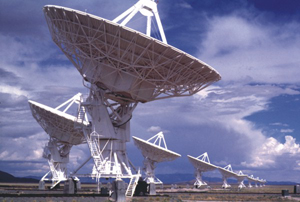A Radio Telescope to Resolve Cosmic Evolution
The EVLA Project (an upgrade to the existing VLA array) will provide a radio telescope of unprecedented sensitivity, resolution, and imaging capability by modernizing and extending the existing Very Large Array. When completed, the EVLA will provide the following capabilities:
1. Sensitivity: Continuum sensitivity improvement over the VLA by factors of 5 to 20, to give point-source sensitivity better than 1 microJy between 2 and 40 GHz.
2. Frequency Accessibility: Operation at any frequency between 1.0 and 50 GHz, with up to 8 GHz bandwidth per polarization.
3. Spectral Capability: Full polarization (8 GHz bandwidth per polarization), with a minimum of 16,384 channels, frequency resolution to 1 Hz, and 128 independently tunable sub-bands.
4. Resolution: Angular resolution up to 200 / (frequency in GHz) milliarcseconds with tens of Kelvin brightness temperature sensitivity at full resolution.
5. Low-Brightness Capability: Fast, high fidelity imaging of extended low-brightness emission with tens of arcseond resolution and microKelvin brightness sensitivity.
6. Imaging Capability: Spatial dynamic range greater than 106, frequency dynamic range greater than 105, image field of view greater than 109 with full spatial frequency samplng.
7. Operations: Dynamic scheduling, based on weather, array configuration, and science requirements. “Default” images automatically produced, with all data products archived.
National Radio Astronomy Observatory


Tags
Map Type
GeoJSON
Map Source
More Info
Attribution
Jim Lee, ClimateViewer NewsMap: The Expanded Very Large Array (EVLA) by Jim Lee is licensed under a Creative Commons Attribution-NonCommercial-ShareAlike 4.0 International License. Based on a work at climateviewer.org/. Permissions beyond the scope of this license may be available at climateviewer.com/terms.
 You are free to:
You are free to:
- Share — copy and redistribute the material in any medium or format
- Adapt — remix, transform, and build upon the material
- Attribution — You must give appropriate credit, provide a link to the license, and indicate if changes were made. You may do so in any reasonable manner, but not in any way that suggests the licensor endorses you or your use.
- NonCommercial — You may not use the material for commercial purposes.
- ShareAlike — If you remix, transform, or build upon the material, you must distribute your contributions under the same license as the original.

